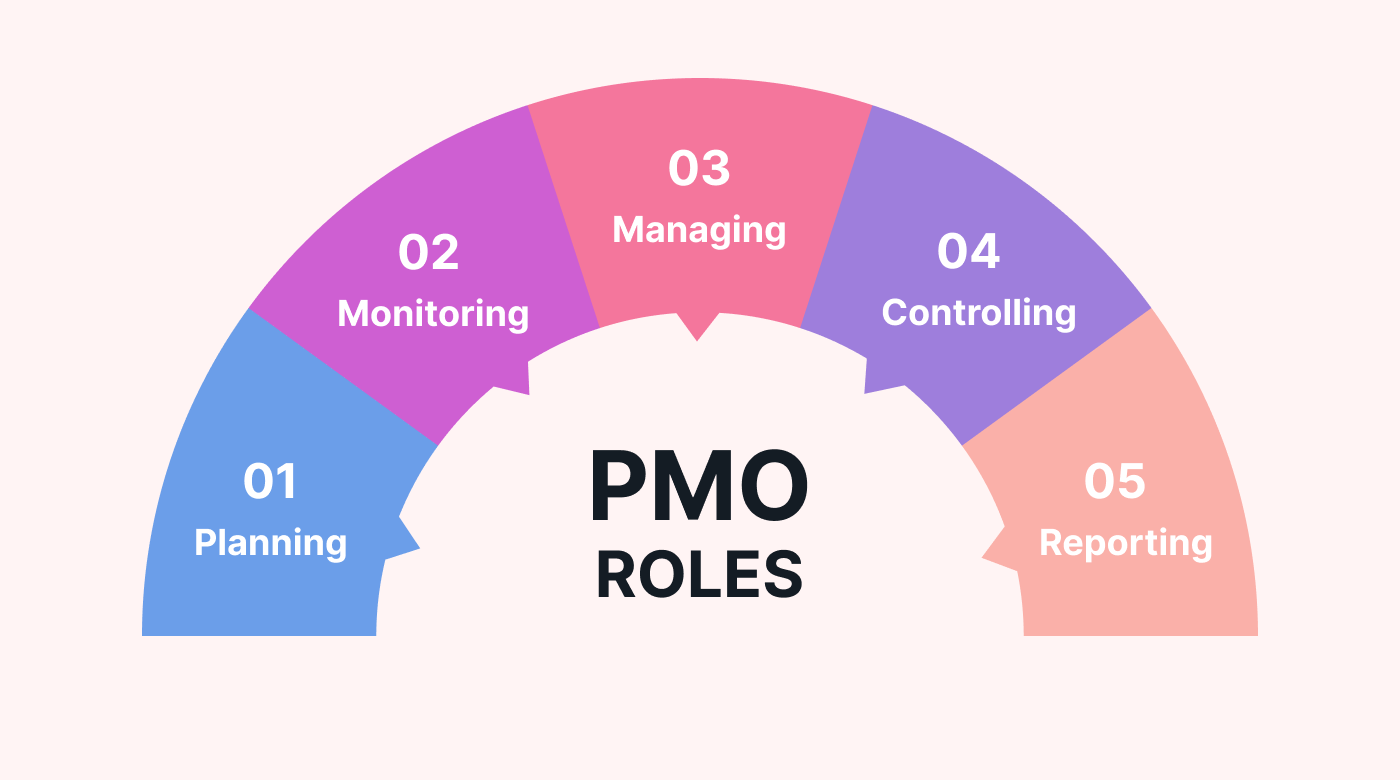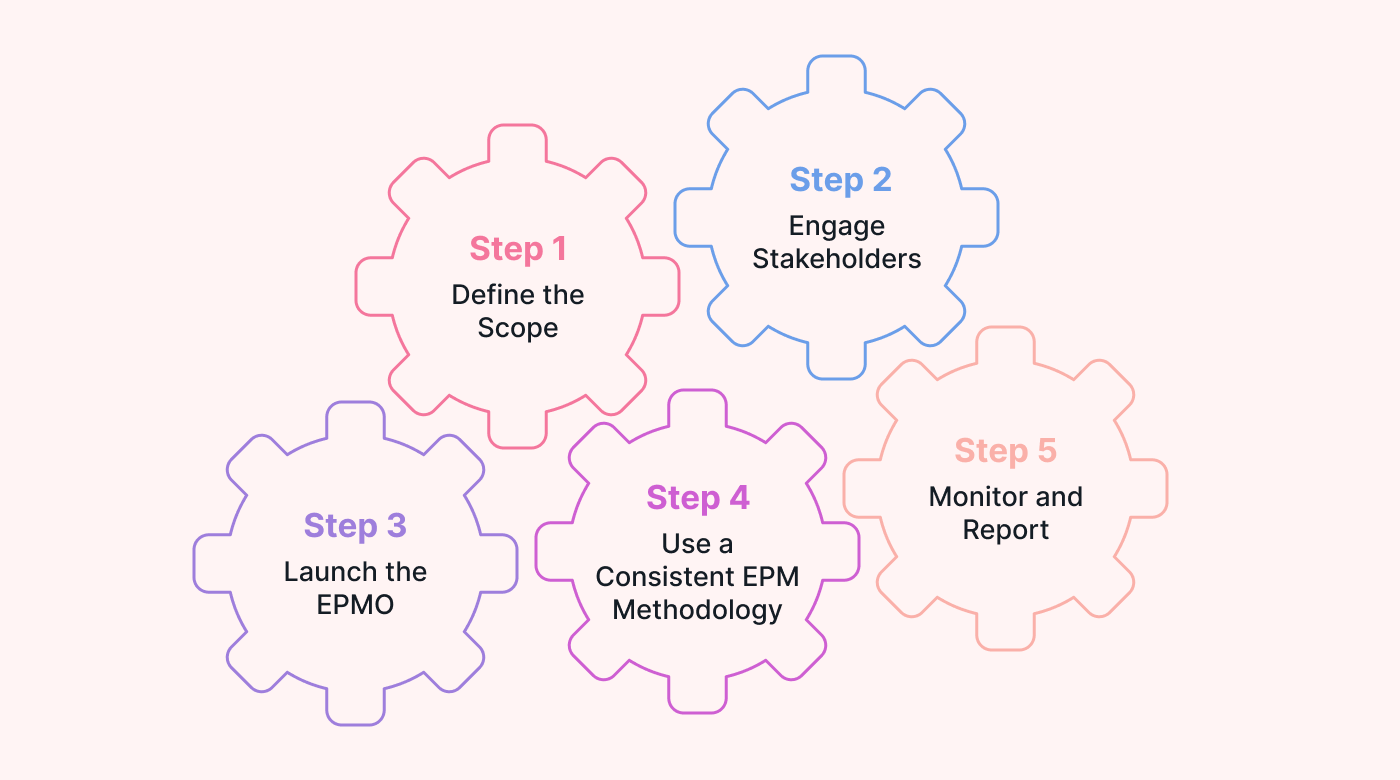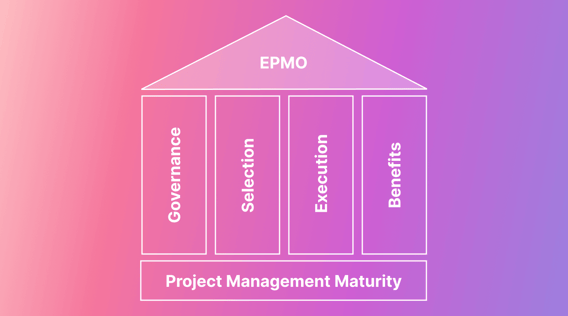Most organizations run several projects simultaneously. The projects may be profit-driven or mandatory. Profit-driven projects might have goals of increased market share or revenue. In comparison, mandatory projects could aim to conduct safety audits.
Businesses should define processes for prioritizing, selecting, and reviewing their portfolio of projects.
Small businesses can leverage an enterprise project management office (EPMO) to prioritize projects based on their contribution to organizational goals. According to a report published in 2021, at least 43% of top-level managers of high-performing businesses identify enterprise-wide project management skills as integral to business success.
This article covers the main concepts of EPMO, including:
- Benefits of having an EPMO,
- How it compares to a traditional PMO,
- Steps for transitioning to an EPMO,
- Challenges of running a successful EPMO, and
- Practical strategies for running an effective EPMO.
If you own a small business, you might be the EPMO. If so, this article can help you think about your business objectives and how to use them to select and manage projects to maximize benefits.
What is an enterprise project management office (EPMO)?
An EPMO aims to select and manage a balanced portfolio of projects to maximize the delivery of strategic benefits to an organization.
An EPMO is a link between an organization’s strategy and delivering the benefits of its projects. The EPMO formulates and defines the company’s portfolio strategies. It is also responsible for providing a framework for and overseeing the portfolio management process.
The portfolio management process begins with prioritizing the organization’s objectives and ends with realizing the strategic benefits resulting from the projects in the portfolio. Of course, it never ends – it just keeps adjusting and delivering.
This includes defining the criteria for selecting and prioritizing the projects in the portfolio. The EPMO then provides governance and oversight of the portfolio management process, including planning and implementing periodic project portfolio reviews.
Businesses often face new opportunities for growth and challenges that hinder their operations. Each unique opportunity or threat often requires significant resources to exploit or neutralize. Businesses need a well-defined plan to prioritize where to invest, reducing the risk of wasting resources on the wrong projects.
EPMO vs. traditional PMO
EPMO and traditional PMO should not be used interchangeably. They are different in terms of their scope and proximity to the executive leadership of an organization. However, to distinguish these two terms, we must first understand what a traditional PMO entails.
What is a traditional PMO?
A project management office (PMO) is a unit or department within an organization that oversees how projects are implemented. One primary role of PMOs is ensuring projects are completed within the stipulated timeline and allocated budget. PMOs may achieve this by owning a set of project managers and a methodology for conducting projects.
 |
How EPMO is different from a traditional PMO
EPMOs and traditional PMOs differ based on their scope and roles. For example, an EPMO reports to executive leadership and can provide strategic recommendations. It can recommend which projects should be retained or dropped based on performance or continued value.
EPMO may also recommend introducing new projects to balance the portfolio. In contrast, the PMO may provide recommendations but not at an enterprise-wide strategic level. For example, PMOs report on different projects’ performance, challenges, and risks. They may also recommend addressing various project risks and increasing the company’s project success rates. However, they generally cannot recommend enterprise-wide changes to how a company runs its portfolio.
Traditional PMOs and EPMOs differ regarding their roles in a company’s project portfolio strategies and critical organizational goals. On the one hand, EPMOs ensure that the project portfolio and its business strategies remain aligned.
EPMOs achieve this by identifying and prioritizing projects that contribute most to company goals. On the other hand, traditional PMOs’ objectives are derived from those of the EPMO. When EPMO strategies change, the PMO’s objectives and project teams’ roles are often bound to change, but not vice versa.
Five benefits of implementing an EPMO
Companies and small businesses stand to gain a lot from having an EPMO. At the basic level, companies enjoy better project portfolio management, likely improving their bottom line. However, the benefits of EPMOs go beyond just that.
Improved organizational success
Having an EPMO increases the chances of organizational success. The primary objective of any EPMO is ensuring that a company identifies and prioritizes projects that offer the most benefits to organizational goals. This means that a functional EPMO assesses the project portfolio often, ensuring it comprises projects that provide the most value to a company.
Improved resource allocation
Most companies do not have access to unlimited resources. Even companies with deep pockets are not looking to squander their resources, as every profit-driven business hopes to maximize its ROI. EPMO boosts resource utilization by ensuring that companies allocate the most resources to projects that offer the most value.
Strategic alignment
Small businesses often struggle with strategic alignment as they focus on survival and growth. They are likely to jump on projects that do not align with their objectives because they look promising. EPMO solves this issue by ensuring the project portfolio aligns with organizational objectives. It also ensures that top-level managers do not make emotional decisions and approve pet projects that don’t align with organizational strategies.
Centralized clearinghouse for business data
EPMOs use standard processes and guidelines to run the PPM process, including selection, prioritization, and implementation. All the projects in the portfolio are monitored and assessed using pre-defined guidelines. This makes it easy to determine why a project was dropped, added, or retained in the portfolio.
Improved collaboration
A good EPMO should have strong relationships with all organizational functions. This allows clear communication of EPMO strategies to all relevant stakeholders. The EPMO must also have the support of executive leadership and senior management. For example, the executive team must collaborate with the EPMO to maintain the best-balanced portfolio.
Five simple steps for launching an EPMO
Given the benefits companies gain from having an EPMO, small businesses should consider setting one up. The EPMO must not be a whole department costing thousands of dollars. Small business owners can double up as EPMOs for their startups.
 |
Define how the company will use the EPMO
The first step when setting up an EPMO is establishing how a business will use it. More often than not, businesses set up EPMOs to improve how they run their project portfolios. Businesses must also define the expected roles of the EPMO. The C-suite executives or small business owners will define this.
Companies must define the governance model. This includes answering the questions: Who makes what decisions, about what, and at what level and why? Companies must also answer: What are the necessary information flows from whom to whom and in what direction?
Engage stakeholders about launching the EPMO
An EPMO’s success relies on the support of relevant stakeholders. Executive leaders ensure the EPMO launches and achieves its objectives. For example, executive managers should cultivate a shared vision for the EPMO.
This includes communicating the EPMO’s roles. The executive leaders should also drive stakeholder enthusiasm for the EPMO.
Launch the EPMO
The EPMO should be launched following a well-defined implementation plan. A company should prepare a detailed implementation plan during Step 1. This is when defining what the EPMO will do.
A good implementation plan should include personnel training. This ensures that EPMO personnel understand their roles and functions. It may start with recruiting the requisite expertise from outside, especially skilled portfolio managers. It then allows the company to plan training programs for its existing personnel. Companies may also recruit employees from within the organization with relevant EPM skills.
Relevant stakeholders should be updated about the impact of EPMO implementation. This goes a long way in retaining their support.
Use a consistent enterprise project management methodology
The EPMO should be launched with a clear set of governance procedures. The EPM methodology should be based on the governance model defined when outlining how the company will use the EPMO. This includes who makes which decisions and how information and authority flow within the EPMO and company.
An essential success tip in this step is to stick to the selected EPMO framework approved by the C-suite execs and communicated to the stakeholders.
Monitor and report performance
The EPMO should review the project portfolio management process to assess performance. The evaluation should result in reports that are shared with the stakeholders. Part of the report should include the EPMO’s strengths and weaknesses. This should be followed by recommendations for addressing inefficiencies within the EPM methodology.
Four common challenges of implementing an EPMO
According to PMI, organizations that meet all four criteria for project performance (scope, budget, schedule, AND benefits realization), have a 92% success rate compared to only 33 percent for organizations that do not. EPMOs are in place to ensure that these criteria are met.
Given the high project failure rate where these criteria are not met, it’s not surprising that some companies do not implement their EPMOs successfully.
 |
Several factors can lead to EPMO failure, some of which are discussed below:
Lack of support from executive leadership
Executive leaders must empower the EPMO to oversee the portfolio management process. Given that the EPMO recommends which projects should be added or dropped from the portfolio, there should be rapport with the executive leaders. Lack of support may mean the EPMO does not receive the resources it needs to execute its functions.
Resistance to change
It is human nature to resist change. This is common when one does not understand how it impacts them. For example, EPMOs sometimes face resistance from functional departmental heads. They may be unwilling to answer to the new authority, especially regarding ongoing projects.
EPMOs may also face resistance from executive leaders who previously approved their pet projects to be implemented.
Resource constraints for effective EPM implementation
Effective EPM can be capital-intensive, which may be a stumbling block for small businesses. Implementing an EPMO may require recruiting skilled experts and contracting consultants, which costs money. Companies also need to train their employees about EPM. Such activities may strain small businesses, which often face budget constraints.
Poorly-defined organizational strategic goals
Some EPMOs fail because their objectives are too vague. The rule of thumb for EPMOs is that objectives should be derived to support organizational goals. The objectives should also be prioritized based on their contribution to the most important organizational goals. This step also provides a basis for sharing the available resources among the projects.
Five effective strategies for running an effective EPMO
Businesses should put effective strategies in place to ensure their EPMOs are successful. Otherwise, they risk sinking resources into an unsuccessful launch. More importantly, a failed EPMO also means a company may maintain an unbalanced portfolio, failing to meet its most important goals.
 |
Let’s discuss the strategies below.
Have well-defined EPM goals and roles
The roles of the EPMO should be defined. This includes what they will do and how they should do it. The EPM methodology should outline the EPMO’s goals and roles and how it will undertake them. This includes the required expertise, roles, power, and delegation.
Derive the EPMO project portfolio goals from organizational objectives
The project portfolio of course must align with the organizational goals, and that’s a major responsibility of the EPMO. Without that, both the portfolio and the EPMO are bound to fail.
The organizational objectives should be prioritized, as they make different contributions to the company goals. Company objectives can be conflicting, and that’s OK as long as they are prioritized. Prioritization allows the EPMO to allocate portfolio and project resources to the most important organizational objectives, while still balancing the portfolio and performing mandatory projects..
Establish strong governance and oversight regulations
The EPM process should have a well-defined governance model. The governance and oversight guidelines should be outlined when defining what the EPMO will do.
Like the company strategy, the EPMO process should be periodically reviewed to identify and address arising challenges. For example, a review may reveal that the decision-making process needs to be adjusted or improved.
Encourage a collaborative culture
EPM requires collaboration among all relevant stakeholders across different managerial levels. The executive leadership must encourage buy-in and a sense of ownership among them. Collaboration also reduces resistance, allowing the EPMO to fulfill its roles.
Implement standardized EPM processes
A standardized EPM process is easy to communicate and monitor. Moreover, everyone knows their roles and what they should do in specific circumstances. It also reduces inefficiencies from delayed decision-making as the EPM governance model defines who makes which decisions.
A standardized EPM is easy to monitor. The EPM methodology outlines how often the EPM process should be reviewed and its key performance indicators.
Improve how you run your projects by launching an EPMO
All profit-driven companies and even non-profit and government organizations) must prioritize suitable projects to help them achieve their most important objectives. One way to accomplish this is by implementing an EPMO that selects and manages the company’s project portfolio. The EPMO’s objectives should align with the organizational goals. This ensures that its efforts drive the company in the desired direction.
Small business owners can use Motion to manage the projects the EPMO selects. For small businesses, the owner often doubles as the EPMO. Such owners can use Motion to create projects, assign tasks to team members, and track their progress.
Motion can also manage the team’s calendars. It schedules what should be worked on next based on the priorities and deadlines. Motion also automatically reschedules the team’s calendars when new tasks are added based on their assigned urgency and importance.
To get started, sign up for Motion’s free trial today!





